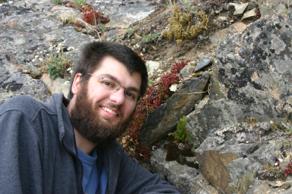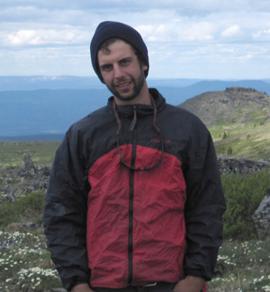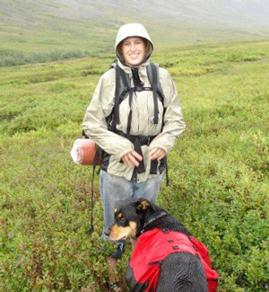2009 & 2010
2010: Jordan Metzgar
Deciphering the past to predict the future: glacial refugia and climate change resilience in ferns

Jordan is pursuing a Ph.D. in Biology by focusing on the diversification and climate responses of parsley ferns (Cryptogramma). These small rock ferns span the boreal forest worldwide, with three species present in Alaska. Jordan selected the group for his study system because of their boreal distribution and frequent preference for glacial associated habitats. This makes the parsley ferns an ideal group for reconstructing the responses and migration events associated with abrupt climate changes such as the end of the Last Glacial Maximum or present day anthropogenic climate change.
His research will use DNA sequences from parsley fern populations along the western coast of North America. By analyzing these samples, highly diverse populations that served as refugia during the Last Glacial Maximum can be identified. The speed and timing of the ferns migration following the retreat of the glaciers can also be determined. Jordan will also use ecological niche modeling to project the present and future ranges of parsley ferns in western North America. This will allow the identification of range shifts or contractions caused by anthropogenic climate change. By combining the results of the DNA migration study and ecological niche modeling, he will be able to project if parsley ferns will be able to adapt to climate change easily or if they will require additional conservation measures.
Thanks to the Hopkins Fellowship, Jordan was able to obtain a GPS unit to record accurate locality data for use in the ecological niche modeling. He has also used it to begin generating DNA sequence data from Cryptogramma specimens from western North America.
2010: Louise Farquharson
Temporal changes in thermokarst lake paleo-nutrient levels and C sequestration, within thermokarst lake basins
Under construction, Information coming soon.
2010: Phoebe Gilbert
Micromorphology, Site Formation Processes, and Climate Change at the Mead Site (XBD-071): A Multi-Component Archaeological Site in the Interior Alaska
Under construction, Information coming soon.
2009: Benjamin Gaglioti
Fossil cuticle analysis of graminoid foliage in Beringia

Ben is an MS student in Biology whose thesis aims to elaborate paleoecological inferences
based on ancient plants stored by arctic ground squirrels in Eastern Beringia. Specifically,
he is identifying grass and sedge foliage from these and other Late-Pleistocene plant
assemblages. Grasses and sedges were the main constituent of the mammoth steppe vegetation
in Beringia, and their identity has been understudied. This work intends on testing
how locally common steppe and tundra vegetation were in Pleistocene Beringia.
Foliage identification techniques are based on the nature and abundance of several
microscopic features on the leaf epidermis (cuticle) that can be taxonomically distinct.
These features are retained on much of Beringia’s fossil foliage and available for
surveys using scanning electron microscopy. Once identified, environmental assumptions
can be made about the past by using the modern habitat preferences and grazing adaptation
of those species/genera found.
The Hopkins fellowship award has contributed to Ben’s training and use of the electron
microscope at UAF, as well as radiocarbon dating of Pleistocene ground squirrel caches
from the Fairbanks area. Ben has analyzed foliage samples dating to the Quaternary
from the Yukon Territories, Fairbanks placer mines and the Fox Permafrost tunnel.
2009: Emily Sousa
Patterning and Change Dynamics of a Distinct Forest-Tundra Ecotone Type in Bristol Bay, Alaska

Emily’s research is aimed at describing and investigating geomorphic influences on
tree growth and stand dynamics at unique forest-tundra ecotones in southwest Alaska.
Using dendrochronological analysis to correlate growth rate, germination events, and
climate sensitivity to a variety of potential drivers, this research will provide
forest ecologists and climate modelers with a better understanding of the role that
geomorphic position, disturbance history, and climate play on regulating tree growth
and stand structure in forest-tundra ecotones.
While there are many tree-ring datasets from across Beringia, this is the first intensive
sampling of white spruce at the forest-tundra ecotone in southwest Alaska. Because
the forest-tundra ecotone exhibits unique growth patterns and stand structures, it
is likely that trees are responding to a number of factors beyond climate.
While this work focuses primarily on the Holocene, it may assist in providing a better
understanding of the response of spruce trees and stands to edaphic and climatic influences
that may therefore help interpret Quaternary paleo recrods in subarctic landscapes
subject to disturbance and rapid changes.
Support from the Hopkins Fellowship funded travel to one of the field sites in King
Salmon, AK allowing for intensive core sampling of white spruce and as well as sampling
of edaphic microsite factors at the forest-tundra ecotone.


